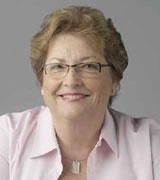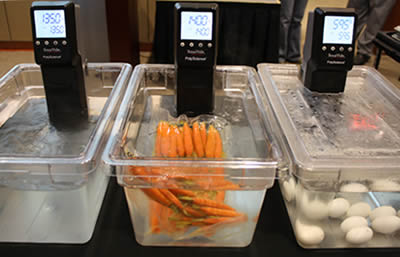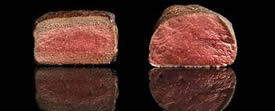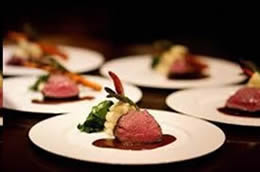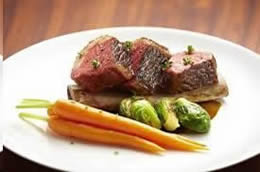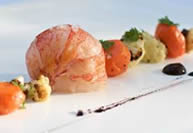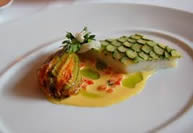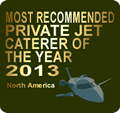| BlueSky Business Aviation News | |||||||||||||||||||||||||||||||||||||
| . | |||||||||||||||||||||||||||||||||||||
Sous vide (pronounced soo-veed - but in the deep southern United States we say sue-veee) means “under vacuum” in French, and sous vide cooking is a gourmet culinary technique long used by chefs worldwide. I might go so far as to say if you have eaten in a high quality restaurant that serves picture-perfect food every time, that establishment is using the sous vide process. The idea of preserving and cooking food in sealed packages is ancient. Throughout culinary history, food has been wrapped in leaves, potted in fat (duck confit), packed in salt, or sealed inside animal bladders before being cooked. People have long known that isolating food from air - accomplished more completely by vacuum sealing - can arrest the decay of food. The sous vide cooking technique involves cooking food in airtight vacuum-sealed pouches, submerged in a water bath or in a temperature-controlled steam environment for longer than normal cooking times - 72 hours for fall-off-the-bone tender and juicy short ribs - at a precisely regulated temperature much lower than normally used for cooking; typically around 55 °C (131 °F) to 60 °C (140 °F) for meats and higher for vegetables. The intention is to cook the item evenly, ensuring that the inside is properly cooked without overcooking the outside, and to retain as much moisture as is possible. The end result? . . . perfectly cooked food each and every time. This process should not be taken lightly as it does have numerous requirements on the strict time and temperature controls in order to maintain a safe-to-eat end product. Best Practice On a recent visit to Upper Sky In-flight Catering at LeBourget Airport in Paris, France, I witnessed their sous vide process. Their food safety standard guidelines are the highest I have witnessed anywhere in the world, not to mention the quality and taste of the food coming out of their kitchen. They have set up their facility based on European Union top manufacturing standards, the pinnacle of the food operations standards pyramid, requiring numerous additional steps in record keeping and food handling to make sure that everything is done to ensure the safest, highest quality product being delivered from their kitchen. Upper Sky has even added a special room for sous vide vacuum sealing. It boasts its own air filtration system to make sure no airborne bacteria is sealed in the pouches of raw foods while being prepared. Think about this . . . if the food going in the bag is contaminated in any way, it will come out with the same contamination - possibly even more if not handled correctly. Sous vide food processes, although providing a perfect solution for aviation catering difficulties, is not something that should be considered easy to do. There needs to be a specific HACCP (Hazardous Analysis Critical Control Point) plan for each item used in the sous vide process. Each country, county or district may require different permits just to operate the sous vide system. Here in Georgia, we must have a separate license, other than our normal local government health inspection to use sous vide. HACCP only needs 30 seconds at 150 degrees to kill salmonella, but it will take 15 minutes at 130 degrees. Many of the pathogens also rely on the presence of oxygen to assist in growth so the vacuum sealing retards that process as well. Too long in the anaerobic state and you’re talking botulism. Again I say, trust a professional with training. This process is available for home cooking, BUT, I do not suggest or even recommend that an operator or flight department allows home processed foods on board the aircraft. It requires exacting temperatures and time controls. Sous vide can, if done incorrectly and without very specific training, enable foods to contain salmonella and even botulism. Trust this process only to the best in the industry and the catering source you trust the most, ask if they have an HACCP plan in place for the delicious juicy perfect filet before you order. With all this being said, do I still think it's perfect for aviation? Yes. Aviation presents numerous issues with cooking and/or reheating on board, Foods dry out; their moisture and juices sucked out of the food due to air pressure and altitude. Air pressure, altitude and even sound have an effect on the taste, but this process holds every drop of intense flavor inside the bag while cooking in the water bath. It does not sizzle away and evaporate. The extraordinary flavors are more intense and natural, filled with fragrance and the pure bright lush color of perfectly cooked foods. Equipment When I was first introduced to sous vide, by Air Gourmet In-flight Catering’s French trained chef in Las Vegas years ago, I was surprised at what the cooking unit looked like. It was not some $20,000 oven/range, but plastic lexan tubs of water sitting on the counter with a not so pricy temperature controller, timer and circulator.
Sous Vide Science Another tidbit of food safety trivia: Clostridium botulinum bacteria can grow in food in the absence of oxygen and produce the deadly botulinum toxin, so sous vide cooking must be performed under carefully controlled conditions to avoid botulism poisoning. Basically, food that is heated and served within four hours is considered safe, but meat that is cooked for longer to tenderize must reach a temperature of at least 55 °C (131 °F) within its first four hours of cooking and then be kept there for sufficient time, in order to pasteurize the meat. Pasteurization kills the botulism bacteria, but the possibility of a hardy botulism spores surviving and reactivating once cooled remains a concern. A concern found in many preserved foods and home canned foods, no matter how they are processed. For that reason, precise chilling requirements for "cook-chill" must be followed so that the botulism spores do not have the opportunity to grow or propagate. Pasteurized food can then be stored for up to two weeks at around 3 °C (37 °F) sealed within the vacuum pack. Accept sous vide foods from only well trained food sources! Since the exterior of the meat does not brown, an additional step of searing in a hot pan or a blow touch is needed. Rule out the use of a blow torch on an aircraft. The science behind this does get a bit complicated . . . yet another reason for intense training. Another side bit of trivia for you; this process was “discovered”, or “stumbled upon” by a chef, Georges Pralus, in Roanne, France in 1974, while preparing fois gras. When cooked in this water bath process, the fois gras always retained its original color, its original appearance and lost less amounts of fat. All this plus the fois gras had a much better cooked texture. Viola! By placing the food in a water bath whose temperature is set at the desired final cooking temperature of the food, overcooking can be avoided because the food cannot get hotter than the bath it is in. When using sous vide the temperatures are lower than for conventional cooking methods, improving the lusciousness of the cooked food. At these lower temperatures, cell walls of the proteins do not burst, resulting in the color staying in the food rather than escaping into the pot. When meat is sous vide, the tough collagen in its connective tissue is broken down into a gelatin, without heating the meat's proteins high enough so the texture toughens and moisture is pulled out of the meat. On the other hand, when cooking vegetables, where extreme tenderness or softness is seen as overcooked (except in parts of the southern US where we tend to serve our vegetables soft, many times stew-like), the ability of the sous-vide technique to cook vegetables at a temperature below the boiling point of water allows vegetables to be thoroughly cooked, as well as being pasteurized (a good thing for pregnant women and individuals with compromised immune systems), while maintaining a firm or somewhat crisp texture. Since the cell walls do not generally burst, the vibrant fresh color will remain. Foods seasoned prior to sous vide are more intense when completed. Yet another plus for aviation. Results I decided to see if I could locate some photographic examples of the difference between conventional cooked foods and sous vide and found these illustrations:
Another great candidate for sous vide is fish. Overcooking fish can happen in a matter of a single minute. In the photo, both salmon filets were cooked to the same internal temperature of 48°C / 118°F. The fillet on the left was cooked sous vide while the fillet on the right was cooked in an oven.
The difference is dramatic: the outside of the oven cooked salmon got too hot, which caused the flesh to tighten up and dry out. The bits of white gelatin on the exterior are lost proteins. However, the sous vide salmon holds that vibrant color, it has succulent tasty juices, and produces a soft moist texture. I don’t know about you, but I prefer to eat the sous vide salmon.
But what about the joy of cooking? I would not be giving you the whole truth if I neglected to mention my personal negative side of sous vide . . . and there is a negative side. Sous vide eliminates the role of your senses. One of the greatest pleasures I have when cooking and creating a meal is the aroma it brings to the kitchen, the love and passion I feel when I touch the food, and the calmness that overcomes me when I can simply stir a sauce round and round - I love the smell of onions sweating in butter (a smell that was my mothers secret way of stalling my father when he came home from work and dinner wasn’t ready. He could smell something cooking and knew dinner was in the works). My mouth waters at the sound and smell of a curry bubbling on the stove, or a cake baking in the oven. With sous vide, no touching, smelling, tasting, listening, looking, or engaging with the food is required. Science has taken our place here. But, if your passenger loves fish but can’t stand the remaining stinky smell on board the aircraft when flying across the ocean, then this is your perfect solution for the perfect meal. If you strive for consistency, then this is your solution. As we look at sous vide for the aircraft, you may ask why I think it is so perfect since it can be so unsafe in the hands of an untrained catering operation. Well . . .
The perfect solution for aviation’s standard pitfalls can be provided by a well trained sous vide expert.
Let me introduce myself . . . My name is Paula Kraft and I am founder and President of Tastefully Yours Catering, an aviation specific caterer, located in Atlanta, Georgia for 35 years.
Currently I am an active member of the NBAA Flight Attendant Committee Advisory Board and the NBAA International Flight Attendant Committee, Women in Corporate Aviation, Women in Aviation International, National Association of Catering Executives, International Flight Catering Association, the International Food Service Association and the International Caterer’s Association. I have coordinated training programs and clinics for NBAA, EBAA and BA-Meetup conference attendees for over 10 years, created mentoring programs for caterers and flight attendants to broaden their aviation culinary skills, and to assist them in adapting to the unique challenges and constraints found in catering for general aviation. I recognize the need for training and have worked closely with flight departments, flight crews, schedulers and customer service reps at the FBOs to ensure that catering specific training provides information and skills necessary to reduce risk while assisting them in their job duties that include safe food handling, catering security, accurate transmission of food orders, and safe food production, packaging and delivery. I fell into aviation catering quite by accident. I was the in-house caterer and bakery supplier for Macy’s department stores in Atlanta when catering was ordered for a Macy’s customer which was soon to change my life. After the client enjoyed the catering provided, I was summoned to the client’s corporate office to provide several of the items delivered through Macy’s to the executive dining room. Within a week, I was providing food for the flight department and my first order was for the President of a foreign country (as I was too be told soon after). So, here I am, some 35 years later, still loving every minute of every day in aviation catering.
|
|||||||||||||||||||||||||||||||||||||
